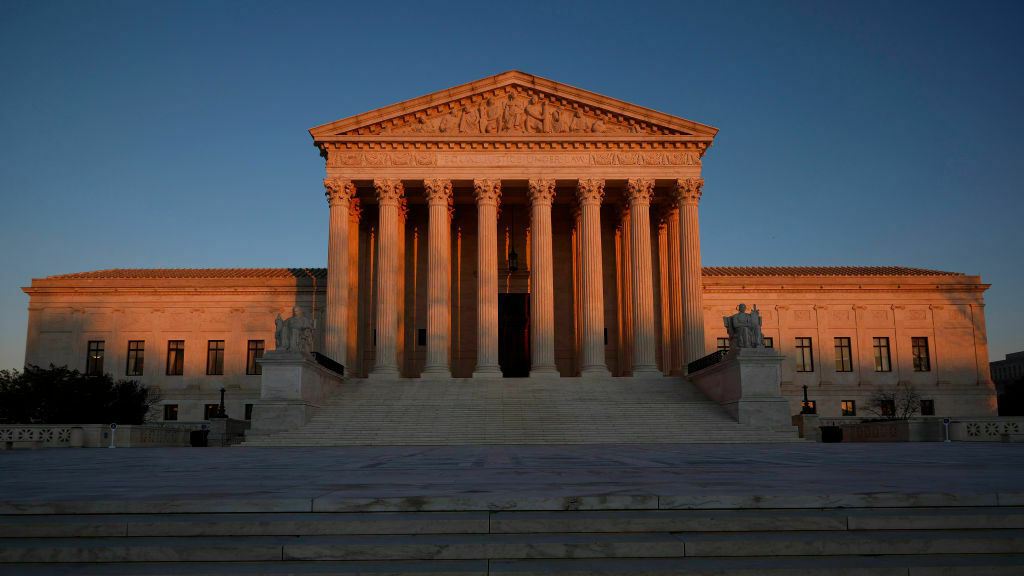
[ad_1]

The U.S. Supreme Court
Chip Somodevilla/Getty Images
hide caption
toggle caption
Chip Somodevilla/Getty Images

The U.S. Supreme Court
Chip Somodevilla/Getty Images
The U.S. Supreme Court has for all practical purposes upheld a new congressional redistricting plan in Louisiana that provides for a second majority Black district. But the court’s decision appears to be limited to the current 2024 election cycle.
At the same time that the court upheld the creation of a second majority-Black congressional district in Louisiana, the justices said that a new challenge to the second district could be filed, a challenge that the court would hear next term, too late for the 2024 election, but with the potential to hobble what remains of the Voting Rights Act.
The 6-to-3 vote in the case was a difficult to understand, with the court’s six conservative justices voting to allow the Louisiana plan for two majority-Black districts to go into effect, while the court’s three liberals would not have intervened at this point. Election Expert Rick Hasen said that the liberals likely disagreed because Wednesday’s case appears to give the court an additional tool to OK or veto congressional redistricting plans months before an election.

The Louisiana congressional redistricting has had a tortured history since the 2020 Census. In 2022, a federal district court ruled that the new map drawn by the state legislature violated the Voting Rights Act by diluting the Black vote. In a state that has six congressional seats, and a 31.4% Black population, only one district was majority Black. The state subsequently appealed to the Supreme Court, but the justices put the case on hold in 2022 while it considered a similar redistricting case from Alabama, and in the interim, the state used a plan that had been held to violate the the Voting Rights Act.
When the justices decided the Alabama case last June, however, they ruled in favor of the Black voters, declaring that the Alabama map had violated the Voting Rights Act by diluting the Black vote instead of adopting a reasonable map that included two majority or near-majority Black voters. At the same time, the justices retracted their earlier decision to grant Louisiana’s petition for review, instead sending the case back to the court of appeals to either draw new congressional lines itself or allow the state legislature to do it.

Ultimately, the appeals court gave the state legislature the first bite at the apple. The Republican-dominated legislature then drew new congressional district lines that included two majority black districts, but the new map was otherwise aimed largely at protecting incumbents, including Mike Johnson, who would subsequently become Speaker of the House, and Steve Scalise, the Republican majority leader of the House.
At that point, the case took a new twist; a group of conservatives calling themselves “non-African-American voters” challenged the legislature’s map, contending it amounted to a racial gerrymander in violation of the Constitution’s guarantee to equal protection of the law. Because this was a constitutional, not a statutory challenge under the Voting Rights Act, it had to be assigned to a three-judge court. As luck would have it, the panel included two Trump appointees. And, by a 2-to-1 vote that court ruled that the state legislature’s map relied too heavily on race, and thus was unconstitutional.
The state promptly appealed to the Supreme Court seeking an emergency stay that would preserve the current map, with two majority Black districts, for this election cycle. The clock is ticking, the state said, and the secretary of state asserted that her office needed to know by Wednesday, May 15, what the congressional district lines are so that candidates know what districts they are going to file in for the primary.
“This case screams for a Purcell stay,” the state argued, a reference to the Supreme Court’s so-called Purcell ruling, in which the justices said that courts should not interfere with election rules and procedures too close to an upcoming election.
University of Texas law professor Stephen Vladeck opined that Wednesday’s action is one of the rare cases in which the Supreme Court has applied the Purcell rule to benefit Democrats, since Louisiana’s second majority-Black district is highly likely to elect a Democrat, meaning the addition of one seat for Democrats in the U.S. House of Representatives.
That said, nothing is certain beyond this election cycle because the Supreme Court almost certainly will be hearing the “non-African-Americans” constitutional challenge next term.


The state, seeking to have its cake and eat it too, indicated it likely would support the “non-African-Americans” next term. If the Supreme court were ultimately to agree, that would be a major body blow to what remains of the once highly-prized Voting Rights Act.
Bottom line: the Supreme Court has allowed the Louisiana’s new congressional map to go into effect, but with a sword of Damocles over its head, namely the constitutional challenge to the Voting Rights Act.
[ad_2]